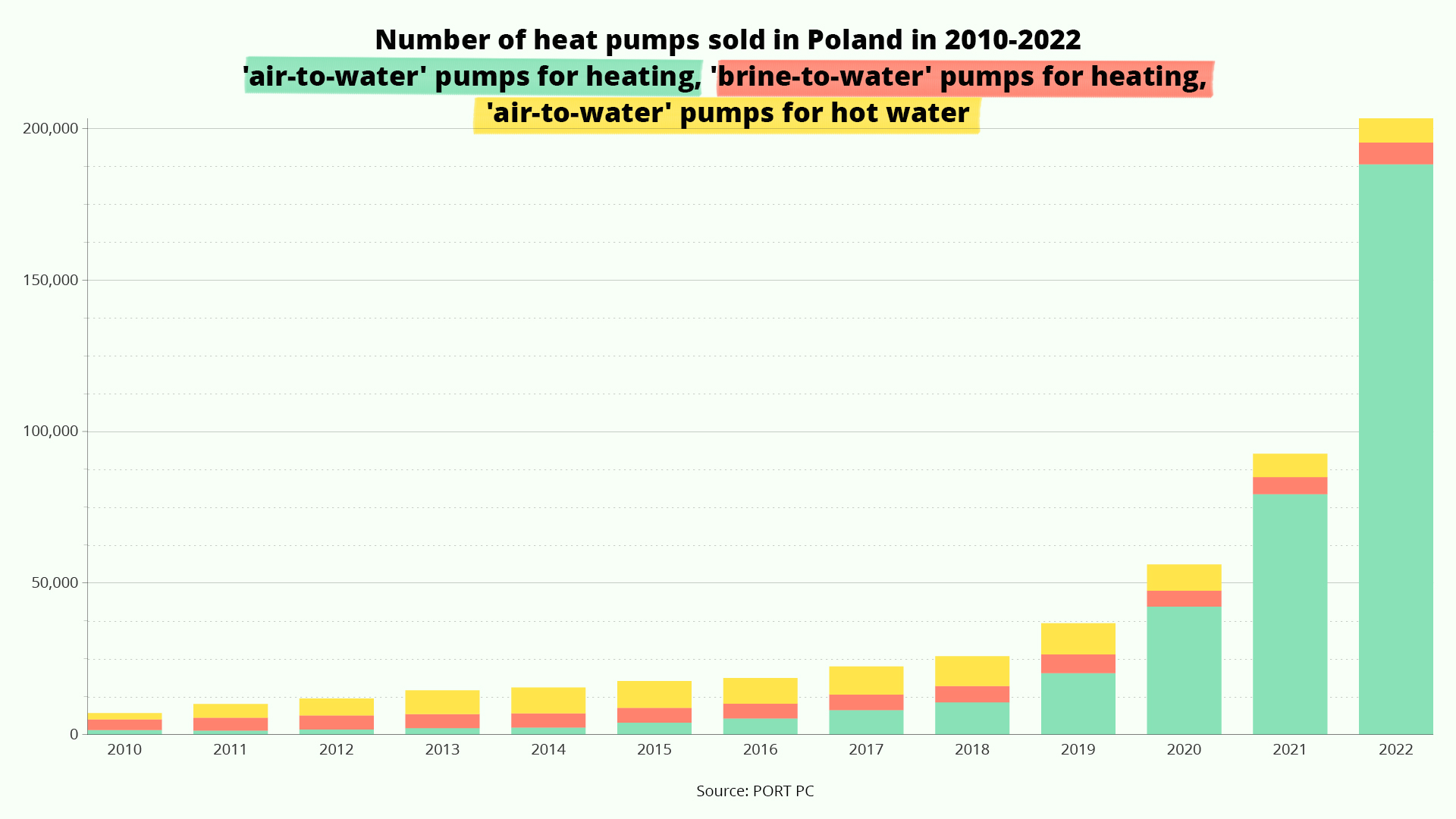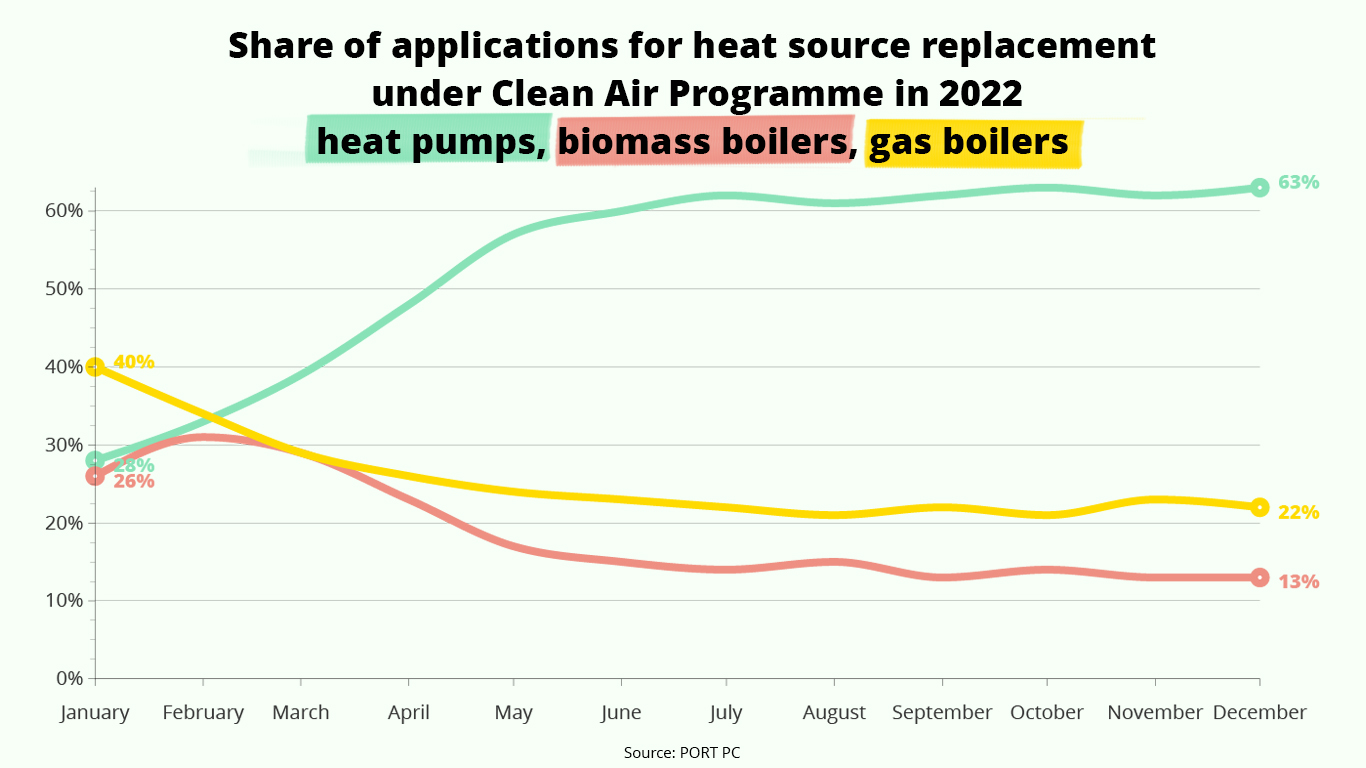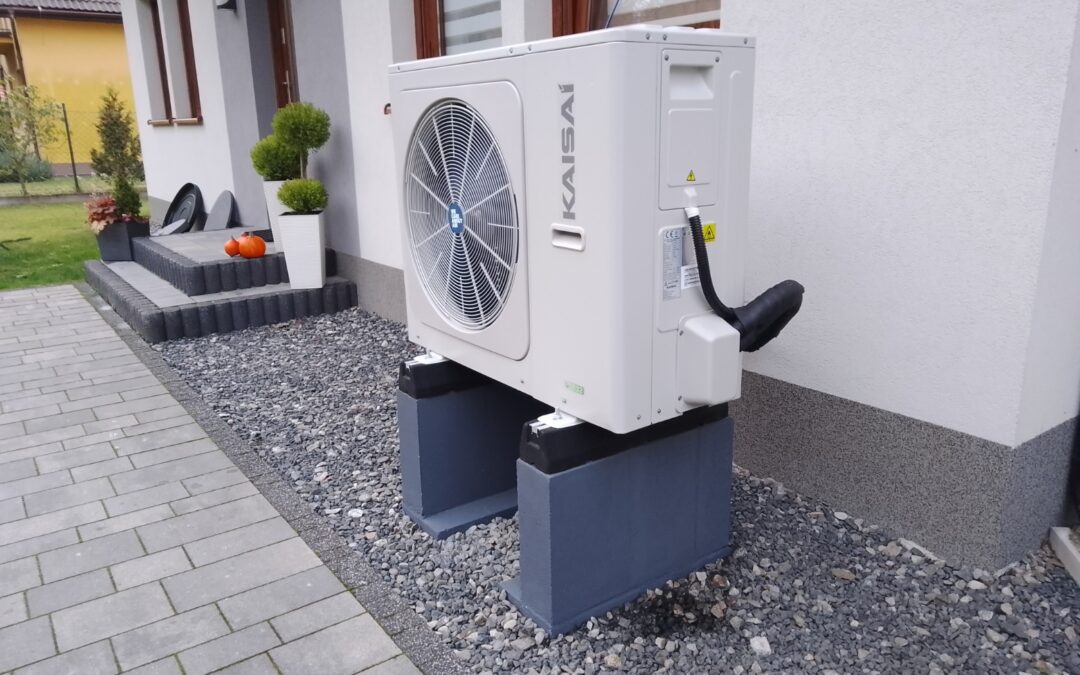By Alicja Ptak
Poland has been Europe’s fastest-growing market for heat pumps for the last three years, a process accelerated further by the war in Ukraine. It is also now becoming a major manufacturing hub for the devices.
Before Russia’s invasion of Ukraine, Robert Kubacki, a 40-year-old graphic designer who lives in Orłowo, a small village in central Poland, had heated his home by burning coal, like around one third of Polish households.
But after the start of the war, the price of the popular coal pellets he used, known as ekogroszek in Polish, soared and stocks often stood empty for days, forcing Kubacki, like many others, to seek a more affordable and reliable replacement.
He had long considered installing a heat pump, which works like air-conditioning in reverse, transferring thermal energy from outside a building to the inside. As a father of a child with a disability, he wanted to release himself from chores around the coal heater for a more “hands-off” solution.
But the high price of a heat pump – on average around 50,000-55,000 zloty (€10,730-11,810) – discouraged him.
The government has approved an allowance of 3,000 zl (€630) to households for buying coal after admitting that a recent plan to cap prices has failed
Around 35% of Polish homes use coal for heating and 11.5bn zloty will be allocated for the new programme https://t.co/Zj7YPA8utL
— Notes from Poland 🇵🇱 (@notesfrompoland) July 19, 2022
“We were dragging our feet,” Kubacki told Notes from Poland. “We had [the pump] booked, but we waited until the last minute, thinking that maybe the price of ekogroszek would come back down.”
Finally, when the price of coal pellets reached almost 4,000 zloty a tonne, up from around 800 zloty previously, he caved, taking advantage of state subsidies and a loan to install a heat pump.
The Kubacki family is one of tens of thousands of Polish households that decided to stop heating their homes by burning fuels, as coal and gas prices skyrocketed in the aftermath of the sanctions imposed on Russia for its aggression against Ukraine.
While the vast majority of Poles still support those sanctions, many, especially those using traditional energy sources, have seen their disposable income significantly eroded by high fuel prices and soaring inflation.
Annual inflation accelerated again to reach 18.4% in February, its highest level since 1996.
Economists believe that the figure will mark a peak and price growth will slow in the coming months.
For more, see our report: https://t.co/jQiEj7pqh7 pic.twitter.com/huAoyvCclS
— Notes from Poland 🇵🇱 (@notesfrompoland) March 15, 2023
Poland produces a lot of coal domestically, but this is mostly of a quality suitable only for burning in power plants. Households in the past relied in large part on coal imported from the east – a route that was ended by Russia’s war.
In this environment, solutions once mostly lauded as environmentally friendly but which remained niche due to prohibitive prices, have become not only more viable economically but also seen as more reliable in the long term. This has heated up the market, which was already seeing at least double-digit annual growth in the past five years.
The Polish Organisation for the Development of Heat Pump Technology (PORT PC), an industry group, reports that 2022 saw a record rise for the Polish heat pump market, with a 137% increase in air-to-water heat pumps – the most common type – sold.
In total, more than 203,000 heat pumps of all types were sold in Poland in 2022, only 33,000 less than in Germany, which has a population over twice as large. The growth in sales of heat pumps in Poland has been the fasest in Europe for each of the last three years, notes the European Heat Pump Association.

Sun-pro, a Polish company once specialised in solar collectors and solar panels – another booming industry in Poland – but now offering installations of heat pumps, saw an even more dynamic growth in sales of over 300%. The firm added heat pumps to its portfolio a few years ago in response to customer requests, and they now make up 30% of sales.
The company’s vice president and co-founder, Adrian Bartoś, admits that the surge in fuel prices, especially for coal and gas, was behind growing demand for heat pumps last year.
However, he also points to the incentives created by a state subsidy system that has stimulated the market in recent years and changed the customer profile from middle and upper class to middle and lower class, allowing even poorer customers from rural centres to install a heat pump.
The Polish government's Clean Air programme is to stop subsidising coal stoves.
It currently offers funds to help households upgrade to more modern and less environmentally harmful coal heaters https://t.co/vddooECA63
— Notes from Poland 🇵🇱 (@notesfrompoland) May 21, 2021
“A heat pump used to be so synonymous with being affluent,” Bartoś told Notes from Poland.
But the government’s “Clean Air” programme – which provides subsidies for installing various green energy solutions in homes, including heat pumps, with financing of up to 66,000 zloty (€14,420) per project – “has mobilised a group of people from a completely different [wealth] level,” he adds.
According to Bartoś, subsidies together with the war-fueled rise in energy prices, have cut investment payback time for heat pumps by roughly one third, to three years.
Under the Clean Air programme, which was initially intended to help households replace coal-fired heaters with a variety of cleaner alternatives, as well as to subsidise thermal insulation, over the past year the share of requests for heat pump funding has risen from 28% to 63%, while applications for gas-fired boilers have dropped from 40% to 22%.

The Clean Air programme is, moreover, only one of seven available in Poland that provide state subsidies for heat pumps. Such programmes have already helped the country make impressive leaps in the development of its prosumer energy market – where the consumer is also a small-scale producer of energy.
Thanks to the success of programs supporting solar panels, Poland has quickly increased the number of micro-installations, whose electricity output doubled in 2022.
The Polish government is now eyeing heat pumps as the next big thing for household energy. To do that, it has recently expanded its popular “My Electricity” (Mój Prąd) programme to include the technology.
Under the programme, residents of Poland, regardless of their income level, will be able to count on subsidies for up to 50% of the investment costs for renewable energy sources for their homes, up to a maximum of 58,000 zloty, of which up to 28,500 zloty can go towards a heat pump.
Poland is expanding a programme offering subsidies to households for green energy investments.
The amount of money available per project will be doubled and eligible technologies will be expanded to include heat pumps and solar thermal collectors https://t.co/VCEVgrMg6w
— Notes from Poland 🇵🇱 (@notesfrompoland) March 20, 2023
Poland’s prime minister, Mateusz Morawiecki, said earlier this month that he hopes this will create “a boom for heat pumps”. “We have proven that environmental protection and energy security need not be mutually exclusive and can be combined,” he added.
The surge in demand for heat pumps also entails a number of challenges for companies, such as staff shortages and delays in equipment deliveries in a market still affected by post-pandemic supply chain disruptions.
Manufacturers are, however, now increasingly seeing Poland as a location for producing, not just consuming, heat pumps.
This month, Japanese manufacturing giant Daikin began construction of a heat pump factory in Poland while Germany’s Bosh announced the construction of another. The two investments combined are estimated at nearly half a billion euros and are expected to create 3,500 jobs.
However, according to the PORT PC, which sees the Polish heat pump market growing by as much as 40-50% in 2023, the shortage of heat pump installers will remain a ”significant barrier” for the market’s development.
Japan’s Daikin this month began construction of a €300 million heat pump factory in Poland, which had Europe's fastest-growing market for heat pumps last year https://t.co/hUcGMXtVss
— Notes from Poland 🇵🇱 (@notesfrompoland) April 20, 2023
After his first winter of heating his home without using coal pellets, Kubicki says he has no regrets about installing a heat pump.
“There are people who still blindly believe in black energy, coal. I personally think, now at least, we should get rid of it as soon as possible,” says Kubacki. “Not to be more eco-friendly, but to be more independent.”
The government appears to agree, given the state funding it has put into heat pump subsidies. However, 70% of the electricity in Poland that powers those pumps still comes from coal-fired plants.
The government has pledged to shift to renewables and nuclear over the coming decades, but has made clear that, for at least the next ten years, and probably longer, coal will remain the country’s primary source of power.
Poland’s climate ministry has outlined plans for the country to generate three quarters of its electricity from zero-emissions sources by 2040, with 51% coming from renewables and almost 23% from nuclear https://t.co/CksVqGQXkV
— Notes from Poland 🇵🇱 (@notesfrompoland) April 4, 2023
Main image credit: Sun-pro

Alicja Ptak is deputy editor-in-chief of Notes from Poland and a multimedia journalist. She has written for Clean Energy Wire and The Times, and she hosts her own podcast, The Warsaw Wire, on Poland’s economy and energy sector. She previously worked for Reuters.




















